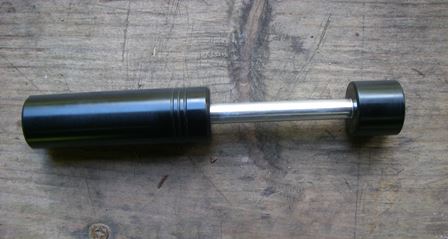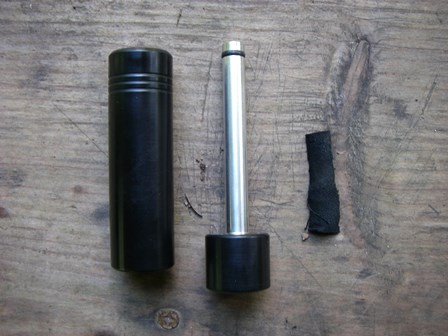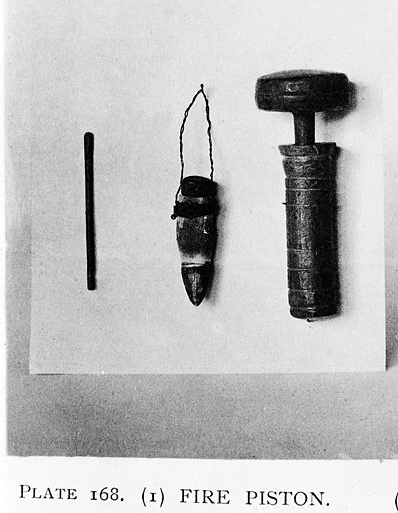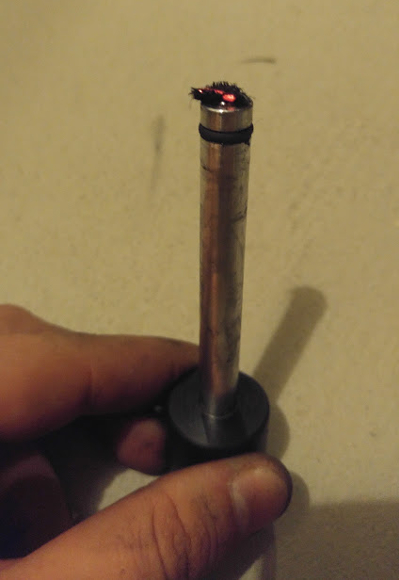The Fire Piston

by Filip Tkaczyk
The fire piston (also known as a fire syringe or slam rod fire starter) is a tool for fire making that has prehistoric origins. This effective tool was made and used by a variety of cultures throughout the Southwest Pacific archipelagos. It is still in use today and made popular as a wilderness tool because of its effectiveness and portability.
Parts of the Fire Piston
The fire syringe has 3 main parts to it: the piston, the cylinder and tinder. The piston must be fitted perfectly to the inside of the cylinder so as to maximize compression pressure. Often, the piston is lubricated with some kind of oil to help it slide more smoothly within the cylinder as well as to reduce friction. The tinder is place in the cupped, bottom end of the piston. This tinder is generally some very fine material, especially material with a low combustion temperature such as char cloth.

Modern fire pistons are often made out of aluminum. Historically they were made with bamboo, horn, wood or antlers.

Pictured in the photo above is a historic fire piston.
How it Works
The piston works on the principle that when a gas is compressed, it increases that gas's temperature and pressure. The piston is forcefully slammed into the cylinder to create this compression. The heat caused by the compression is transferred to a tinder material, igniting it. Rapidly, the piston is withdrawn so that the little coal can receive oxygen in order to continue to burn. This tiny coal is then blown on and added to a much large bundle of tinder material. Finally, that bundle is blown into a flame. Hopefully, at this point you already have made a good fire structure to stick this flaming ball of tinder into and can sit back and watch it burn.

This photo shows the tiny coal produced, immediately after ignition.
Helpful Tips
The principle behind the fire piston is simple, but sometimes in practice there can be certain challenges. Most of these challenges have to do with improper use of this fire-making tool. Here are a few especially useful tips to keep in mind as you practice.
First, because of the need for compression force, the piston and cylinder must be perfectly matched so that air and heat energy do not escape. Add a very thin coat of oil to the piston if it is not working smoothly.
Second, it is vital to withdraw the piston immediately after plunging it into the cylinder, so as to let the coal be fed by oxygen. If it is left there for more than a split second, it will likely be extinguished due to lack of air.
Third, be especially careful with the tinder material. Make sure it is seated in the end of the piston, with just a little bit of it protruding. Also, be sure that when you withdraw the piston, the tinder also is withdrawn even if it does not ignite. If the material gets stuck inside the cylinder, it will stop working until properly cleared out.
Be More Prepared For Your Next Outdoor Adventure!

Don't leave without knowing these six essential survival skills. Our free survival mini guide reveals the strategies of:
- Shelter & fire to prevent the number one cause of death
- Obtaining clean water to avoid life-threatening dehydration
- Common wild survival foods and other critical skills!

Different Kinds of Tinder
Carrying tinder with you is easy and a good practice in preparedness. But what if you use up all of your tinder or you need to find it in the wild? Here are some good options to try:
- Inner bark of red cedar
- Inner bark of cottonwood
- Inner bark of linden tree
- The cotton-like seed fluff from willow, cottonwood and milkweed pods
- Dry cattail seedhead fluff
- Tinder fungi such as Fomes fomentarius and Inonotus obliquus
- Char cloth
Whenever possible, keep your fire piston and tinder in waterproof containers such as dry bags or ziplock bags. This will keep everything you need contained, organized, and dry for when you need it.
If you want to make your own char cloth, it is simple to do. Char cloth can be made by cutting up an old pair of cotton jeans or t-shirt, and burning it inside of an old Altoids container. Make sure the container has a small hole punctured in it so that as the materials char, it burns away all the oxygen inside. This will allow the cotton to char in a manner that makes it especially susceptible to combustion.
Parting Words
As with nearly all survival skills, this one requires practice. Try out your fire piston using different kinds of tinder. Also try using it to make fire under different conditions, including on sunny days, and windy and rainy ones. The more proficient you get with this handy tool, the more you know you can count on it when it really matters.
Be safe and enjoy the outdoors!
Additional Resources
For purchasing a fire piston, we recommend Wilderness Solutions.
Learn about survival fire starting at our Wilderness Survival Courses.
Return from the Fire Piston Article back to Wilderness Survival Articles
Is The Essential Wilderness Survival Skills Course Right for You? Take the "Online Survival Training Readiness" Quiz
See for yourself if this eye-opening course is a good fit for you. It takes just a few minutes! Get your Survival Training Readiness Score Now!

Grow Your Outdoor Skills! Get monthly updates on new wilderness skills, upcoming courses, and special opportunities. Join the free Alderleaf eNews and as a welcome gift you'll get a copy of our Mini Survival Guide.

 The Six Keys to Survival: Get a free copy of our survival mini-guide and monthly tips!
The Six Keys to Survival: Get a free copy of our survival mini-guide and monthly tips!
Learn more